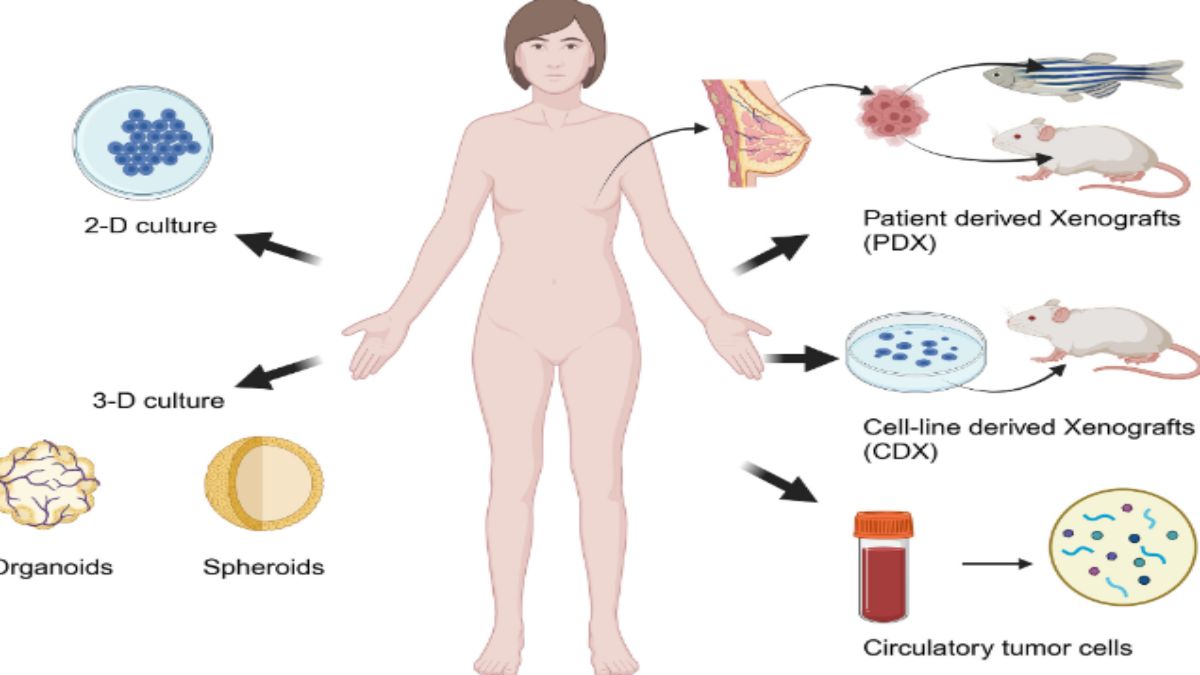Introduction
Breast cancer cell lines are indispensable tools in oncology research, serving as models to study the disease’s biology, test therapeutic agents, and develop personalized treatment strategies. These immortalized cell cultures, derived from human breast tumors, mimic various aspects of breast cancer, providing insights into tumorigenesis, metastasis, and drug resistance. Understanding the characteristics and applications of these cell lines is crucial for advancing breast cancer research and improving patient outcomes.
1. What Are Breast Cancer Cell Lines?
Breast cancer cell lines are cultured cells derived from breast tumor tissues that have been adapted to grow continuously in laboratory conditions. These cell lines retain the genetic and phenotypic characteristics of the original tumor, allowing researchers to study cancer biology in a controlled environment. They are categorized based on hormone receptor status, HER2 expression, and metastatic potential, among other factors.
2. Historical Development of Breast Cancer Cell Lines
The establishment of the first breast cancer cell lines dates back to the 1970s, with the development of MCF-7 and T-47D lines. These early models paved the way for subsequent cell lines, each representing different subtypes of breast cancer. Over the decades, advancements in cell culture techniques and genetic engineering have led to the creation of more diverse and representative models, enhancing the relevance of preclinical studies.Wikipedia
3. Major Breast Cancer Cell Lines and Their Characteristics
MCF-7
Derived from a 69-year-old woman with invasive ductal carcinoma, MCF-7 cells are estrogen receptor-positive and progesterone receptor-positive. They are widely used to study hormone-responsive breast cancer and evaluate endocrine therapies. Wikipedia+2Wikipedia+2Wikipedia+2
MDA-MB-231
This triple-negative breast cancer (TNBC) cell line lacks estrogen, progesterone, and HER2 receptors, making it a model for aggressive and treatment-resistant breast cancer. MDA-MB-231 cells are utilized to investigate metastasis and evaluate novel therapeutic agents. WIRED+5Wikipedia+5Wikipedia+5
SK-BR-3
Originating from a 43-year-old woman with HER2-positive breast cancer, SK-BR-3 cells overexpress the HER2 receptor, serving as a model for studying HER2-targeted therapies. Wikipedia
BT-20
A triple-negative cell line derived from a 74-year-old woman, BT-20 cells are used to study chromosomal abnormalities and their role in breast cancer progression. Wikipedia
MDA-MB-468
This cell line, isolated from a 51-year-old woman, is characterized by mutations in the p53 gene and is employed to study tumor suppressor gene function and drug resistance mechanisms. Wikipedia
4. Applications of Breast Cancer Cell Lines in Research
Drug Discovery and Development
Cell lines are utilized to screen potential therapeutic compounds, assess their efficacy, and identify mechanisms of drug resistance. They provide a platform for high-throughput screening and biomarker discovery.
Mechanistic Studies
Researchers use cell lines to investigate the molecular pathways involved in breast cancer progression, including cell signaling, gene expression, and epigenetic modifications.
Personalized Medicine
By analyzing the response of different cell lines to various treatments, scientists can identify predictive biomarkers and develop personalized therapeutic strategies for patients.Wikipedia+5WIRED+5Wikipedia+5
5. Limitations and Challenges
Despite their utility, breast cancer cell lines have limitations. They may not fully recapitulate the tumor microenvironment, immune interactions, or genetic heterogeneity of primary tumors. Additionally, prolonged culture can lead to genetic drift, affecting the reliability of results.
6. Future Directions in Breast Cancer Cell Line Research
Advancements in organoid technology, 3D cell culture systems, and patient-derived xenografts are enhancing the fidelity of breast cancer models. Integrating these models with genomic and proteomic analyses will provide deeper insights into tumor biology and facilitate the development of novel therapeutic approaches.
Conclusion
Breast cancer cell lines remain a cornerstone of cancer research, offering valuable models to study the complexities of the disease and evaluate potential treatments. While they have certain limitations, ongoing advancements in model systems and technologies continue to improve their relevance and application in breast cancer research.
Frequently Asked Questions (FAQs)
1. What are breast cancer cell lines?
Breast cancer cell lines are cultured cells derived from breast tumor tissues that have been adapted to grow continuously in laboratory conditions, serving as models for cancer research.
2. Why are MCF-7 and MDA-MB-231 cell lines commonly used?
MCF-7 cells are estrogen receptor-positive and used to study hormone-responsive breast cancer, while MDA-MB-231 cells are triple-negative and serve as models for aggressive, treatment-resistant breast cancer.Wikipedia
3. How do breast cancer cell lines contribute to drug development?
They provide platforms for screening potential therapeutic compounds, assessing efficacy, and identifying mechanisms of drug resistance, facilitating the development of new treatments.
4. What are the limitations of using breast cancer cell lines?
They may not fully replicate the tumor microenvironment or genetic heterogeneity of primary tumors, and prolonged culture can lead to genetic drift, affecting result reliability.
5. What are the future trends in breast cancer cell line research?
Advancements in organoid technology, 3D cell culture systems, and patient-derived xenografts are enhancing model fidelity, providing deeper insights into tumor biology, and facilitating novel therapeutic developments.
6. Are there alternatives to breast cancer cell lines in research?
Yes, patient-derived xenografts, organoids, and 3D culture systems are emerging as alternatives that better mimic the in vivo tumor environment

